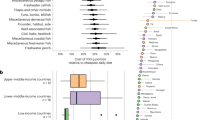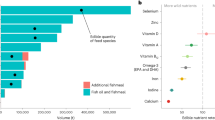Abstract
With declining capture fisheries production, maintaining nutrient supplies largely hinges on substituting wild fish with economically comparable farmed animals. Although such transitions are increasingly commonplace across global inland and coastal communities, their nutritional consequences are unknown. Here, using human demographic and health information, and fish nutrient composition data from the Peruvian Amazon, we show that substituting wild inland fisheries with chicken and aquaculture has the potential to exacerbate iron deficiencies and limit essential fatty acid supplies in a region already experiencing high prevalence of anaemia and malnutrition. Substituting wild fish with chicken, however, can increase zinc and protein supplies. Chicken and aquaculture production also increase greenhouse gas emissions, agricultural land use and eutrophication. Thus, policies that enable access to wild fisheries and their sustainable management while improving the quality, diversity and environmental impacts of farmed species will be instrumental in ensuring healthy and sustainable food systems.
This is a preview of subscription content, access via your institution
Access options
Access Nature and 54 other Nature Portfolio journals
Get Nature+, our best-value online-access subscription
$29.99 / 30 days
cancel any time
Subscribe to this journal
Receive 12 digital issues and online access to articles
$119.00 per year
only $9.92 per issue
Buy this article
- Purchase on Springer Link
- Instant access to full article PDF
Prices may be subject to local taxes which are calculated during checkout



Similar content being viewed by others
Data availability
Data used are available in the main text and Supplementary Data 1.
Code availability
All code is available upon request from the corresponding author.
References
Tilman, D. & Clark, M. Global diets link environmental sustainability and human health. Nature 515, 518–522 (2014).
Hicks, C. C. et al. Harnessing global fisheries to tackle micronutrient deficiencies. Nature 574, 95–98 (2019).
SOFIA 2020—State of Fisheries and Aquaculture in the World 2020 (FAO, 2020).
Godfray, H. C. J. et al. Food security: the challenge of feeding 9 billion people. Science 327, 812–818 (2010).
Kawarazuka, N. & Béné, C. The potential role of small fish species in improving micronutrient deficiencies in developing countries: building evidence. Public Health Nutr. 14, 1927–1938 (2011).
Belton, B. & Thilsted, S. H. Fisheries in transition: food and nutrition security implications for the global South. Glob. Food Sec. 3, 59–66 (2014).
Hilborn, R., Banobi, J., Hall, S. J., Pucylowski, T. & Walsworth, T. E. The environmental cost of animal source foods. Front. Ecol. Environ. 16, 329–335 (2018).
Froehlich, H. E., Runge, C. A., Gentry, R. R., Gaines, S. D. & Halpern, B. S. Comparative terrestrial feed and land use of an aquaculture-dominant world. Proc. Natl Acad. Sci. USA 115, 5295–5300 (2018).
Heilpern, S. Integrating Food Webs and Food Security to Understand the Impact of Biodiversity Loss on Ecosystem Functions and Services. PhD thesis, Columbia Univ. (2020).
Ministerio de Desarrollo Agrario y Riego (Midagri); https://www.gob.pe/midagri
Ministerio de la Producción (Produce); https://www.gob.pe/produce
OECD-FAO Agricultural Outlook, 2019 edn (OECD/FAO, 2020).
Peru—National Program for Innovation in Fisheries and Aquaculture Project (World Bank, 2017).
DeFries, R. et al. Metrics for land-scarce agriculture. Science 349, 238–240 (2015).
Loreto: Resultados Definitivos de la Población Economicamnte Activa 2017 (Instituto Nacional de Estadistica e Informática, 2018).
McIntyre, P. B., Liermann, C. A. R. & Revenga, C. Linking freshwater fishery management to global food security and biodiversity conservation. Proc. Natl Acad. Sci. USA 113, 12880–12885 (2016).
Youn, S.-J. et al. Inland capture fishery contributions to global food security and threats to their future. Glob. Food Sec. 3, 142–148 (2014).
Kawarazuka, N. & Béné, C. The potential role of small fish species in improving micronutrient deficiencies in developing countries: building evidence. Public Health Nutr. 14, 1927–1938 (2011).
Bogard, J. R. et al. Nutrient composition of important fish species in Bangladesh and potential contribution to recommended nutrient intakes. J. Food Compos. Anal. 42, 120–133 (2015).
Vaitla, B. et al. Predicting nutrient content of ray-finned fishes using phylogenetic information. Nat. Commun. 9, 1–10 (2018).
Popkin, B. M. Nutrition, agriculture and the global food system in low and middle income countries. Food Policy 47, 91–96 (2014).
Bogard, J. R. et al. Higher fish but lower micronutrient intakes: temporal changes in fish consumption from capture fisheries and aquaculture in Bangladesh. PLoS ONE 12, e0175098 (2017).
Golden, C. D., Fernald, L. C. H., Brashares, J. S., Rasolofoniaina, B. J. R. & Kremen, C. Benefits of wildlife consumption to child nutrition in a biodiversity hotspot. Proc. Natl Acad. Sci. USA 108, 19653–19656 (2011).
Davis, K. F. et al. Meeting future food demand with current agricultural resources. Global Environ. Change 39, 125–132 (2016).
Parker, R. W. R. & Tyedmers, P. H. Fuel consumption of global fishing fleets: current understanding and knowledge gaps. Fish Fish. 16, 684–696 (2015).
Parker, R. W. R. et al. Fuel use and greenhouse gas emissions of world fisheries. Nat. Clim. Change 8, 333–337 (2018).
Avadí, A. et al. Comparative environmental performance of artisanal and commercial feed use in Peruvian freshwater aquaculture. Aquaculture 435, 52–66 (2015).
Fry, J. P., Mailloux, N. A., Love, D. C., Milli, M. C. & Cao, L. Feed conversion efficiency in aquaculture: do we measure it correctly? Environ. Res. Lett. 13, 024017 (2018).
Prudêncio da Silva, V., van der Werf, H. M. G., Soares, S. R. & Corson, M. S. Environmental impacts of French and Brazilian broiler chicken production scenarios: an LCA approach. J. Environ. Manage. 133, 222–231 (2014).
Seto, K. & Fiorella, K. J. From sea to plate: the role of fish in a sustainable diet. Front. Mar. Sci. 4, 74 (2017).
Lynch, A. J. et al. Inland fish and fisheries integral to achieving the Sustainable Development Goals. Nature Sustain. 3, 579–587 (2020).
Nardoto, G. B. et al. Frozen chicken for wild fish: nutritional transition in the Brazilian Amazon region determined by carbon and nitrogen stable isotope ratios in fingernails. Am. J. Hum. Biol. 23, 642–650 (2011).
Khoury, C. K. et al. Increasing homogeneity in global food supplies and the implications for food security. Proc. Natl Acad. Sci. USA 111, 4001–4006 (2014).
Kearney, J. Food consumption trends and drivers. Philos. Trans. R. Soc. Lond B Biol. Sci. 365, 2793–2807 (2010).
Pinnegar, J. K., Hutton, T. P. & Placenti, V. What relative seafood prices can tell us about the status of stocks. Fish Fish. 7, 219–226 (2006).
Wong, J. T. et al. Small-scale poultry and food security in resource-poor settings: a review. Global Food Sec. 15, 43–52 (2017).
Tabela Brasileira de Composição de Alimentos—TACO (Núcleo de Estudos e Pesquisas em Alimentação—NEPA/UNICAMP, 2011).
Cahu, C., Salen, P. & de Lorgeril, M. Farmed and wild fish in the prevention of cardiovascular diseases: assessing possible differences in lipid nutritional values. Nutr. Metab. Cardiovasc. Dis. 14, 34–41 (2004).
Vitamin and Mineral Requirements in Human Nutrition (WHO/FAO, 2004).
Fats and Fatty Acids in Human Nutrition: Report of an Expert Consultation (FAO, 2010).
Heilpern, S. A., Weeks, B. C. & Naeem, S. Predicting ecosystem vulnerability to biodiversity loss from community composition. Ecology 99, 1099–1107 (2018).
R Core Team. R: A Language and Environment for Statistical Computing (R Foundation for Statistical Computing, 2020).
Acknowledgements
We thank M. Montoya for supporting field logistics and R. Arbildes-Tello, G. Alvarez and M. Cueva for help with collecting and processing samples. This work was supported through grants to S.A.H. by the NYC Community Trust and the Conservation, Food and Health Foundation. Any use of trade, firm, or product names is for descriptive purposes only and does not imply endorsement by the US Government.
Author information
Authors and Affiliations
Contributions
S.A.H. initially conceptualized the research with substantial input from R.D.F. and S.N. All authors subsequently refined the research goals. S.A.H. led the data analysis and wrote the first draft with all authors subsequently providing input.
Corresponding author
Ethics declarations
Competing interests
The authors declare no competing interests.
Additional information
Peer review information Nature Food thanks K. Seto and the other, anonymous, reviewer(s) for their contribution to the peer review of this work.
Publisher’s note Springer Nature remains neutral with regard to jurisdictional claims in published maps and institutional affiliations.
Supplementary information
Supplementary Information
Supplementary Figs. 1–5.
Supplementary Data 1
List of species and their corresponding traits.
Rights and permissions
About this article
Cite this article
Heilpern, S.A., Fiorella, K., Cañas, C. et al. Substitution of inland fisheries with aquaculture and chicken undermines human nutrition in the Peruvian Amazon. Nat Food 2, 192–197 (2021). https://doi.org/10.1038/s43016-021-00242-8
Received:
Accepted:
Published:
Issue Date:
DOI: https://doi.org/10.1038/s43016-021-00242-8
This article is cited by
-
Food systems transformation, animal-source foods consumption, inequality, and nutrition in Myanmar
Food Security (2023)
-
Variation in Food and Nutritional Stability Among Amazonian Populations Living in a Context of Dramatic Seasonal Flooding
Human Ecology (2023)
-
Small pelagic fish supply abundant and affordable micronutrients to low- and middle-income countries
Nature Food (2022)



